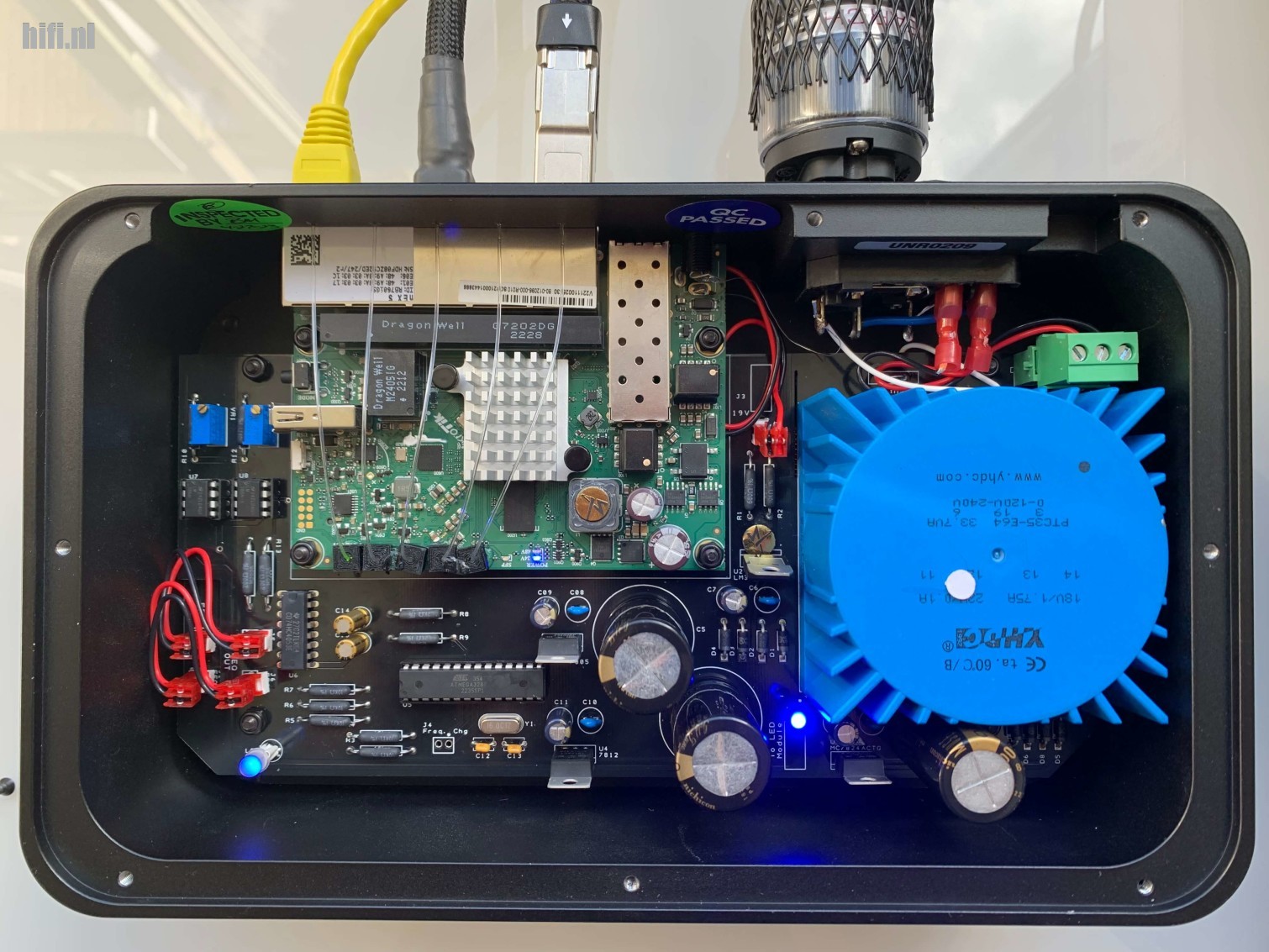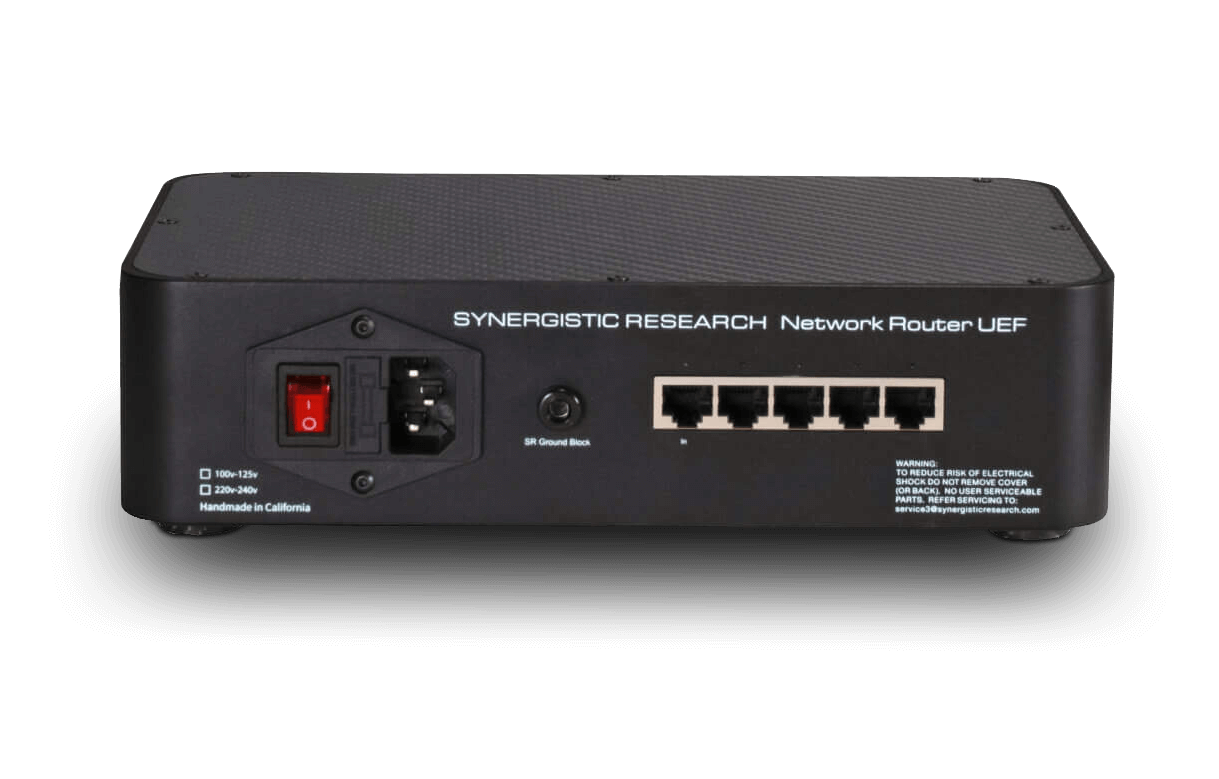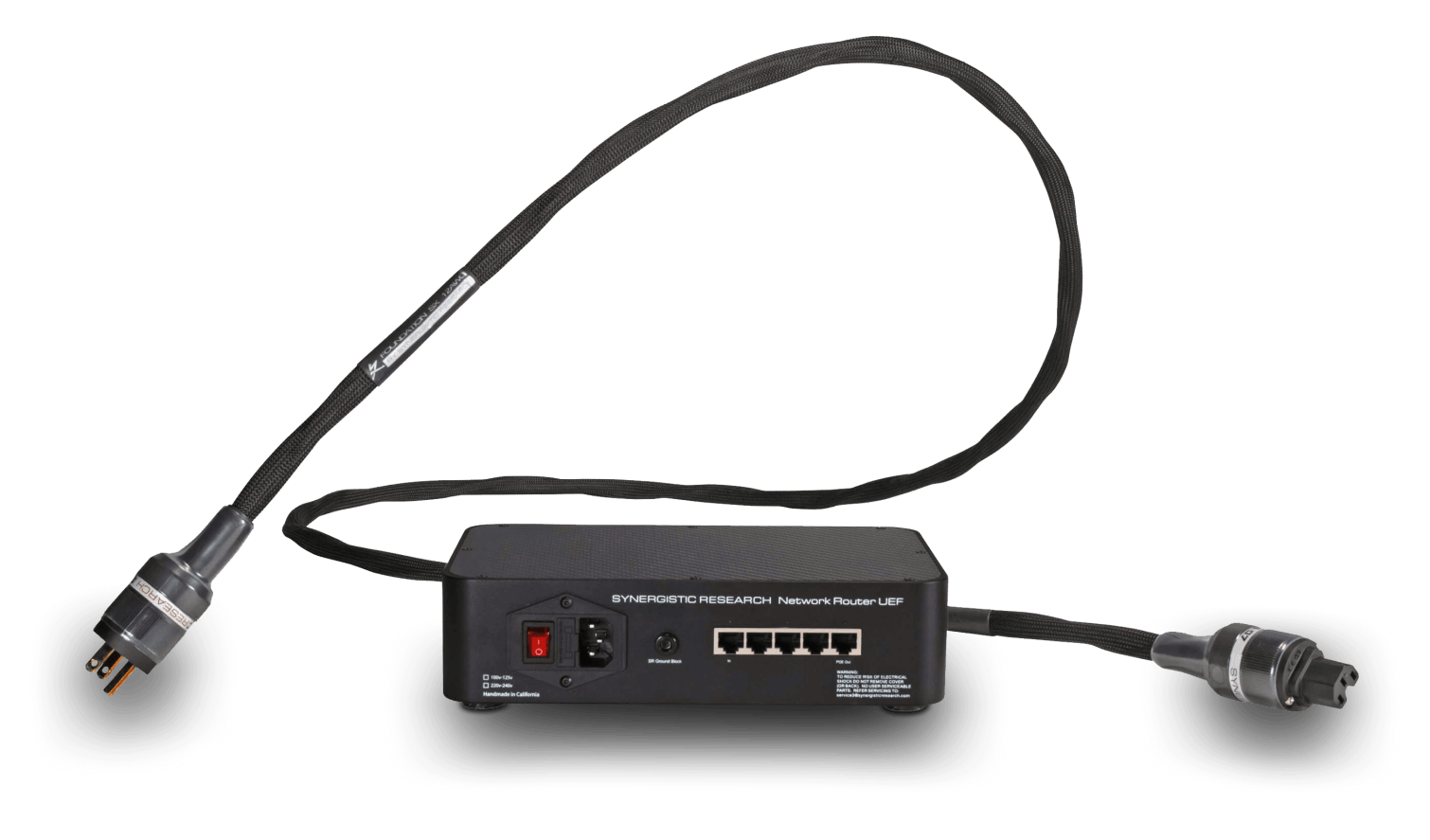
It's maybe just 10 years ago, the world was shaken up by the first reviews on ethernet cables and a bit later, on ethernet switches. Initially, judged by many, a lot of nonsense was sold. Today, only diehard non-believers who think as limited as the digital zeros and ones, do not believe what many music lovers have noticed, that ethernet cables and switches do have their positive or negative influence on the streaming of music. As far as switches go, sometimes cheap solutions are preferred, while in other systems a much more precious solution is the way to go. In all cases it turned out, the power supply has an enormous impact on the performance of a switch. By performance, this time not the throughput is meant, but the ability of the power supply to send lots of the high frequency noise which passes through its ethernet ports to our audio system.
Nowadays, a good switch and a good power supply for it are common in high end audio, but how is this for routers? Well, Synergistic Research is the first manufacturer to come up with an audiophile router, reviewing that one is something I donât want to miss. If it was only to determine whether such a router makes any sense at all.
Network Router UEF mattersÂ
Not too long ago, we reviewed the Synergistic Research Network Switch UEF and the results of this test have been published. Building upon the same concept, an UEF Router was launched. While a switch relays packets of data to and from a switch, without separating these packets from other data packets that have to pass the switch, a router goes one step further. It divides the network into two or more segments with different IP address ranges. Traffic that belongs to segment A will never reach segment B and will never mess up things there. A router, at the same time, is a port that will send data, if needed, from one segment to the other, so connections to the outside world will still be possible (the internet). An ethernet switch just looks into a data packet for sender and destination, and will send the data to the right port without any further questions asked. A router will go one step further than this, determines whether data traffic has to stay within this segment or has to be sent to the neighbors. This is the simple version of it, thereâs much more going on, but we leave that up to IT specialists.

The Synergistic Research Network Router UEF may be an ordinary router, bought at third parties including the software, so the benefits have to be brought in by Synergistic Research themselves. This router is either meant to be connected within an existing network, directly connected to your providersâ router which was set to bridge mode for the internet, or to create a separated segment within an existing network. The router is truly Plug and Play, it obtains an IP address from the network at its primary side and at the secondary side, it gives out IP addresses from a DHCP pool. Unlike most routers, the UEF Router is not equipped with WiFi.
So, if you wish to connect a smartphone or tablet, you need to add and connect a WiFi access point to one of the ports of the UEF Router. This was all done deliberately by SR, by keeping WiFi out of the UEF Router, as any WiFi transmitter will have a high frequency influence on any and all parts of the router, even when the antennae are connected outside and not inside the router.
Integrating the UEF Router will definitely have its impact on the way a network can be setup in your home. In my particular case, I use ROON as the user interface, with a ROON NUC, Auralic and Bluesound streamers, connected to a Melco for the storage of music files. All these devices have the ability to communicate, as long as they are within the same segment of the network. They could all have internet access via an UEF Router. This means storage and players, as well as TV and other devices, must be within one segment.
To give an example: in my home, there are multiple rooms with players, connected to multiple switches. My Auralic may access anything and thus will play my own, stored music as well as music from TIDAL and internet radio, however, would I connect the Auralic solely behind the UEF Router, I would be left with just TIDAL and internet radio. Unless I would start all over again building my network in a different way. You cannot âteachâ an Auralic, Bluesound, Melco or other devices that stored music is in IP range A while it has access to music from IP range B. So, either you should use the UEF Router for your entire home network, or connect your entire music system behind the UEF Router. All people who stream from their music from just one device (and they are the majority of all) will not encounter these problems.
How the Router UEF is builtÂ
By accessing the router via its IP address you will quickly notice the beating heart of it is a MikroTIK router which runs the MikroTIK operating system. On one hand, itâs nice the user can configure the router via its web interface, on the other hand, this poses a risk too. Without thorough knowledge of this stuff, you may easily setup the router completely wrong or you may even lock yourself out of it. Stay away from altering settings if you do not exactly know what you are doing! The router PCB is mounted as a piggyback board on the Synergistic Research power supply board. All this is hidden in a heavy aluminum enclosure and is topped with a carbon fiber lid.

Accessible are five ethernet RJ45 ports, one input and four outputs, one of which has PoE (Power over Ethernet) capability. Covered by the enclosure and made useless that way, are an SFP port and a USB connector. Just like in the UEF Switch, Synergistic Research uses an EM Cell and Active UEF Technology. On top of that, two Schumann generators are incorporated. The EM Cell and âactive UEF Technologyâ using a blue LED generate a wide band electromagnetic field that will harmonize other high frequency electromagnetic interference in the neighborhood, like WiFi, Bluetooth, GSM etc., so this interference will be much less noticeable in cables and HiFi devices. The enclosure houses four independent linear power supply sections, hence the 230V mains input on the back. A PowerCell is incorporated as a mains filter, and of course an SR Purple Fuse comes as a standard. The router board itself rests on a Tranquility Base, an active base pioneered by Synergistic Research which not just absorbs EMI and RF, but even actively counteracts on PCBs and its tracks.
Unlike the UEF switch, the EM cell cannot be seen from the outside. A connector is provided to establish a ground connection to a Synergistic Research Ground Block. Alternatively, this connector can be used to connect the SR Router to ground via the supplied ground cable with a mains plug. The UEF Router measures 2.6 x 10 x 6 inch and has a weight of 6 Pounds. A lot more than my plastic Fritz!Box in the meter cupboard. In the box is an SR Power cord. Dutch distributor Kemp Elektroniks even added two SR Ethernet cables for my review.
Network Router UEF at homeÂ
As described earlier, the SR UEF Router cannot be used in my network without some changes made to it. This is more due to my complex network than to the UEF Router. To completely change the setup of my entire network and partially making it unusable for others using the network at home during the entire review period is just one bridge too far for me. This would have been different if I had started building my network around the SR Router. So, I will use the router in a different way. I use it in a listening room, behind my Fritz!Box router and behind a simple switch, and I connect one streamer to it. This way, I can change the connections: streamer before the SR Router, straight to the simple switch via and Audioquest Vodka cable, or behind the SR Router, using the Vodka entering the SR Router and the SR Foundation SX Ethernet cable running to the streamer.
I used TIDAL as a streaming service and I just listened to what the SR UEF Router would do using an Auralic G1 with Hörwege power supply as my digital source, digitally connected to a Naim DAC-V1 and HiFiman headphones on one hand, while on the other hand a Metrum DAC, EAR/Yoshino amplifier and Falcon LS3/5A loudspeakers were used. I will not bother you with other bells and whistles.Â
Normally, you would install the SR UEF Router as a first and only router in the meter cupboard, using your providersâ modem as a bridge. If desired, connect a WiFi access point to the SR Router together with up to multiple SR UEF Network Switches to distribute data through your house. A good and cheap access point is, for instance, the TP Link, which worked as hassle-free and reliable as the SR Router itself.
Listening on headphonesÂ
Four pieces of music: Lori Lieberman as a singer, Janine Jansen playing classical violin, Youn Sun Nah as an audiophile recording and Haevn as a pop representation with singer. As it is now, straight over the Fritz!Box router and an utterly standard switch, I regard TIDAL using the Lightning DS app from Auralic as uninspired, dull and boring, even though the power supply is an iFi with an Isotek filter and even though the switch has a much better power supply than the standard wall-wart adapter.

The reproduction simply cannot even be compared with my own rips, played from Melco storage via ROON and Melco switches. This became painfully evident compared to yesterday, when I listened for several hours to my normal setup with the headphones on. Now without glass fiber and Melco switch in place, the stereo image has shrunk. Low end is less powerful and messy. Music doesnât sound smooth and has a good amount of âdigital artifactsâ in it. You can hear everything you just donât want to hear, everything that puts streaming in the âno-goâ category for real Audiophiles.
Now, with the SR UEF Network Router in place. Change cables, reconnect the Auralic for a new IP address and move the iPad WiFi to the access point and listen. Whow! This was not what I expected. Thereâs the life, the details, the joy, layers, said in other words: now, thereâs music. And with a much larger stereo image in my head. No, I didnât change the volume level, everything was painstakingly kept the same. Now, the music has bite, rhythm and it convinces me. The effort Lori did, suddenly changed from singing along to singing with a soul, her emotions can be heard. Now, TIDAL is bearable and could be a worthwhile alternative for my own rips. Janine plays with the fire which is the reason I embrace her playing, drive and finesse, details and dynamics.
Youn Sun Nah with her tiny instrument in front of her belly indeed succeeds to place the instrument below her voice and reveals more of the reverberation of the studio, while her voice was sharply focused close to the mike. Grabbing your attention, giving more of an insight as to what actually happened in that studio. Notes had a longer decay time and voices drift away with longer decays. Here, as before, emotion had taken the place of a dull and boring reproduction. At last Haevn with their last track, before I fire up my amplifier. Finally, reproduction actually is spatial and comes close to speakers you are sitting quite near to. Low frequencies are rumbling on, much tauter and with definition this time. The singersâ voice carries on a lot better and lifts off the band. Maybe the reproduction of all tracks is even finer than yesterday, and I now remember I didnât even use my Melco switch at the end of the chain. Cables, cables, cables⦠you can get entangled in them. In case you think Iâm exaggerating things, just try for yourself and I think you will be just as surprised as I am. Suddenly, that high price Synergistic Research commands for âjust a routerâ doesnât seem to be out of place.
On to the speakersÂ
Same music, same order, set volume and donât touch it afterwards. Without the SR Router in the system Lori keeps the instruments glued to the loudspeakers, in a completely flat stereo image herself, in the middle of it. Between her and the speakers is nothing, outside of the physical setup you cannot hear anything either. I simply donât recognize the Falcons. Notes from the piano are harsh without any hint of the body of it. To put it simple: this is utterly disappointing if you know better. Harsh in high frequencies; far from smooth. Janine Jansen the same, no height, no width, no depth.
Unorganized, too fast as it seems, violin on the onset of unbearable. Youn Sun Nah is better, but this is far from complex music. All is in the middle, neatly focused. Her voice is not very interesting. A bit of air around the little instrument, voice flat and lifeless. Finally, Haevn with âthe seaâ. Gooey voice, small stereo image. Even the deep bass wonât come out and sticks to the speakers. Frankly said, if I had to listen to this carefully chosen set that cost me serious money this way, I would have sold the whole lot and bought an all-in-one instead.
So, Iâd better place the SR Router back. Playing Lori, you can suddenly hear things happening between her voice in the middle and left and right speaker. With a fine stereo image in height, and width further than the speakers have distance between each other, and depth. Just like with the headphones on, she now has a soul, brings a message and does so with passion. Music doesnât just stick to the loudspeakers, something the Falcons are known for. The piano now seriously unveils keynotes and the drums sound like⦠drums and metal. Is TIDAL overwhelmingly perfect now? Not exactly, but you can now enjoy it, and is a great way to discover new music. Just my 2 cents, you donât have to agree here. Jansen opens a window to the concert hall. Large, wide and deep, no more too fast and no sharp sounding violin, although it still sounds a bit flat. You cannot have all in life.

Youn Sun Nah seriously lifts off now, notes from that small instrument flows through the listening room, grow as a bubble around her voice. She is more up front, this time she convinces by laying enough emotion in her voice to make me believe what she is singing. Listening nicely and discovering where the small details are, pulled at the edge of your seat by the sheer speed of the reproduction. I could live with this setting. Haevn starts with soft low tones, upon that, the music is slowly built up, something I didnât experience without the SR Router. Notes just sway through the room, voice taut and firm in between. Space emerges, set apart, imposing. Finally, a smooth reproduction and not a touch of harshness.
An SR Router in your route
Itâs an unexpected pleasure to reproduce music with this router in your system, even when, as in my case, you are somewhat limited in its application. My own, stored music was out of reach, but this is all down to my network setup. Experiments with the SR Router UEF were carried out by connecting my streamer directly to the router provided by my provider, with a switch in between. After that, by connecting the SR Router UEF to that same switch with the streamer connected to the SR Router. The differences are by no means subtle, in fact they are impressively large with Synergistic Research being the winner. Another step forward compared to what you can achieve with a precious switch and associated special power supply. Synergistic Research fully lives up to my earsâ expectations. Did I expect that? Yes and no. Yes, because this company is good at manufacturing this kind of upgrades that can do surprisingly well, just think of the UEF Switch or the fuses they manufacture. No, because this massive difference in my setup is a surprise and took off so well. As said: without the SR Router I experience streaming over TIDAL as way under the quality of my own rips played over ROON. With the SR Network Router UEF I could live very well with TIDAL or other streaming services. I strongly recommend the Synergistic Research Network Router UEF to those who want to know how streaming services over the WEB can really perform.
Synergistic Research Network Router UEF
Including SR Purple Fuse and Foundation 12 AWG power cord
3595 euro |Â www.kempelektroniks.nl





